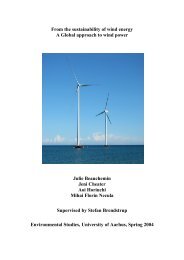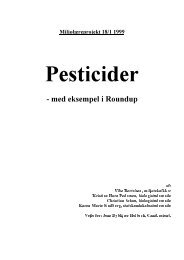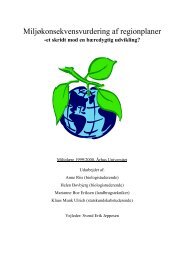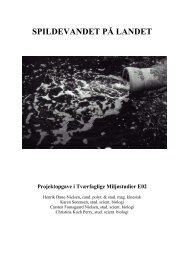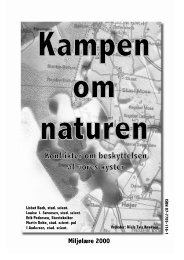University of Aarhus ECOTOURISM AS A WAY TO PROTECT ...
University of Aarhus ECOTOURISM AS A WAY TO PROTECT ...
University of Aarhus ECOTOURISM AS A WAY TO PROTECT ...
You also want an ePaper? Increase the reach of your titles
YUMPU automatically turns print PDFs into web optimized ePapers that Google loves.
Ecotourism as a sustainable way to protect nature<br />
developmental issues <strong>of</strong> the destination they are visiting (Lew, 1997). This<br />
aspect should be a driving force for the next stages <strong>of</strong> development in<br />
ecotourism.<br />
When focusing on ecotourism as a sustainable development tool, which<br />
mainly concerns the biodiversity conservation, it is necessary to mention the<br />
global market share <strong>of</strong> tourism (see table 1).<br />
It is evident that the major part <strong>of</strong> tourists are now concentrated in Europe<br />
or in the Americas, but the major benefits from ecotourism are expected through<br />
biodiversity protection in "hot spots <strong>of</strong> biodiversity" (8) (Primack, 2001).<br />
Recently, the market share <strong>of</strong> the areas concentrating the major part <strong>of</strong><br />
biodiversity is quite low. Therefore, from the marketing point <strong>of</strong> view, there is a<br />
great challenge for the travel industry to extent the focus more into these areas<br />
where market possibilities are abundant. And as mentioned before the<br />
biodiversity is a high value resource and could be included in a marketing<br />
strategy (Mercer, 1997). But this shift is already taking place. As the studies<br />
show, the East Asia and the Pacific have experienced the highest growth (World<br />
Almanac & Book <strong>of</strong> Facts, 2002).<br />
8 Hot spots <strong>of</strong> biodiversity – “key places <strong>of</strong> the world, concentrating high biodiversity, they<br />
have high level <strong>of</strong> endemism and are endangered by extinction and degradation”. There are 25<br />
areas named “hot spots”. For example – South-East Asia, Central America, Caribbic, Central<br />
Africa, Madagascar, Brazilian forests etc. This areas maintain 44% <strong>of</strong> worlds flora, 30% <strong>of</strong><br />
worlds mammals and 54% <strong>of</strong> amphibias (Primack, 2001)<br />
19





